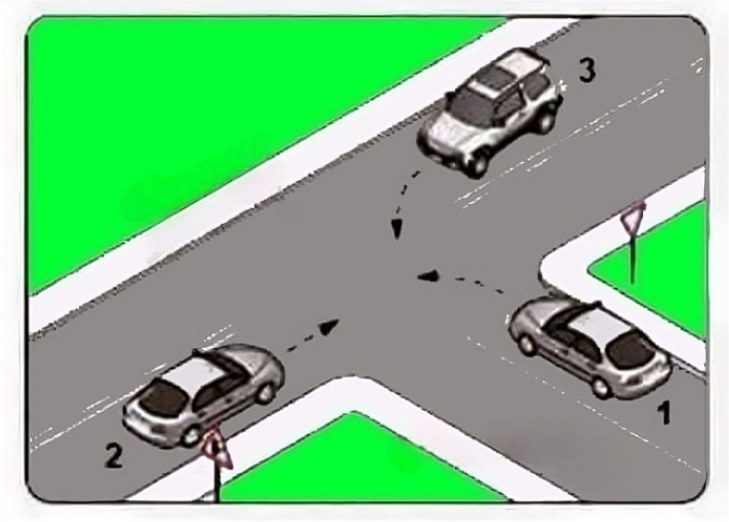Traffic puzzles aren’t just entertaining—they’re a clever way to improve your road sense and logical thinking. The scenario presented is a classic example: three cars, numbered 1, 2, and 3, are at an intersection. The question is simple: Who moves first? However, the solution depends on your attention to detail and understanding of road rules. Let’s solve this puzzle step by step and uncover the correct answer.
Why Traffic Puzzles Matter

Traffic puzzles are more than brainteasers—they mimic real-world driving scenarios and test your knowledge of road safety. These exercises are excellent for reinforcing critical thinking skills while brushing up on essential driving laws. By analyzing each element, you can avoid mistakes both in puzzles and on the road.
Take a moment to picture the situation. Which car do you think moves first? Have your answer in mind as we walk through the solution!
Common Mistakes People Make
Before solving the puzzle, let’s look at some common errors:
1. Ignoring Traffic Signs
One of the biggest mistakes is overlooking critical details like yield or stop signs. These signs dictate the right of way and are essential for solving the puzzle.
2. Making Assumptions
Some people assume the car closest to the intersection or the one on the right always moves first. While these rules can apply in certain situations, they aren’t universal and depend on other factors like traffic signs and road markings.
3. Misinterpreting Priority Rules
Drivers sometimes forget that priority is situational. It’s determined by the type of road, the direction of travel, and the specific rules in place. Misunderstanding these nuances often leads to errors.
Now that we’ve identified these pitfalls, let’s dive into solving the puzzle.
Step-by-Step Solution to the Traffic Puzzle
Step 1: Observe the Traffic Signs
The first step is to look at the traffic signs at the intersection. Here’s what we notice:
- Car 2 is on a priority road. Both Cars 1 and 3 face triangular yield signs, meaning they must give way to vehicles on the priority road. This makes Car 2 the first to move.
Takeaway: Car 2 has the right of way and moves first.
Step 2: Compare Cars 1 and 3
Once Car 2 clears the intersection, the focus shifts to Cars 1 and 3. Both vehicles are at yield signs, so neither has automatic priority. However, the right-hand rule applies here: when two vehicles are in the same situation, the one on the right has the right of way.
- Car 3 is to the right of Car 1. This means Car 3 moves next.
Takeaway: Car 3 moves second.
Step 3: The Last Vehicle
With Cars 2 and 3 gone, only Car 1 remains. At this point, it’s safe for Car 1 to proceed through the intersection.
Takeaway: Car 1 moves last.
Final Order of Movement

The cars move in the following sequence: 2 → 3 → 1.
Why This Solution Works
The order is based on two fundamental principles:
- Priority Roads Take Precedence: Cars on a priority road always move first unless there are stop or yield signs indicating otherwise.
- Right-Hand Rule for Equal Priority: When two vehicles face the same conditions, the one on the right has the right of way.
By carefully applying these rules, the correct solution becomes clear.
The Importance of Details in Traffic Puzzles
This puzzle highlights how even minor details—like a yield sign or the position of cars—can determine the outcome. In real-life driving, these details are critical for safety. Overlooking a single sign or misunderstanding the right-hand rule can lead to accidents, making puzzles like this valuable practice tools.
Tips for Solving Similar Traffic Puzzles
- Examine All Signs: Don’t miss key indicators like stop signs, yield signs, or road markings.
- Apply Logical Rules: Use principles like the right-hand rule or priority road guidelines when no explicit signs are present.
- Take Your Time: Rushing often leads to mistakes. Analyze the situation step by step to ensure accuracy.
What’s Your Answer?
Now that you know the solution, take a moment to reflect on your reasoning. Did you get it right on your first try? If not, what detail did you miss? Share your thought process—whether correct or not—in the comments. It’s always fun to see how others approach these puzzles.
Conclusion: A Fun Way to Sharpen Your Skills
Traffic puzzles like this one aren’t just about solving a riddle—they’re about developing better observation and logical thinking skills. By practicing puzzles like these, you’re not only boosting your brainpower but also becoming a more attentive and informed driver.
Remember, the smallest details often hold the biggest clues. Keep challenging yourself with more traffic puzzles, and you’ll find your problem-solving skills improving with every scenario. Happy puzzling, and stay sharp on the road!


